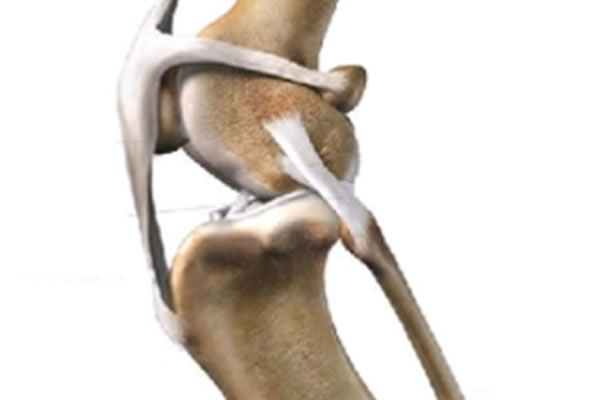What is a Cranial Cruciate Ligament Injury?
The canine knee (stifle) joint is a hinge joint that is anatomically similar to the human knee. Like human athletes, this joint is often involved in injuries causing lameness in the dog and cat. The stifle is composed of ligaments which help stabilize the joint, and menisci which cushion the bones that form the knee (the femur and tibia). The cranial cruciate ligament prevents backward motion of the femur and forward motion of the tibia when there is weight placed upon the hind limb. Injury to this ligament is one of the most common orthopedic conditions and occurs commonly in active dogs who run and jump. Injury occurs when the cruciate ligament tears either partially or fully. These patients experience inflammation of the joint, pain, and instability within the joint. Left untreated, the chronic inflammation of the joint can lead to degenerative osteoarthritis, and progressive lameness.
Diagnosing the Injury
A comprehensive physical examination, a complete history, and radiographs of the knee and hips aid your veterinarian in diagnosing a cruciate ligament rupture. Sudden onset of lameness that is worse after exercise or resting, a toe-touching stance at rest, or even complete reluctance to use the injured leg, can be classic signs of cruciate injury. Patients with a cruciate ligament rupture show discomfort when the joint is manipulated and exhibit laxity between the tibia and femur which is known as “cranial drawer motion” and is diagnostic for injury. This manipulation of the joint often requires sedation due to the muscular resistance of the patient.
Surgical Repair
A ruptured cruciate requires surgical treatment and several options exist. The appropriate surgical technique is dependent on age, breed, severity of the injury, and economics. Recovery from surgery generally takes about 12 weeks. With surgical correction and appropriate aftercare, there is a very good prognosis for a return to normal activity.
At Lodi Veterinary Care, we offer Tibial Plateau Leveling Osteotomy (TPLO) and extracapsular/lateral suture repair as surgical options for our patients.
Our veterinarians will work with you to choose the best treatment for your pet.
Post Operative Considerations
- Recovery from cruciate surgery generally takes about 12 weeks
- Routine post surgery evaluations include visits @ 1, 2, 6 and 10 weeks
- Visits @ 2, 6, and 10 weeks are generally scheduled as a hospital admission to allow for re-evaluation of the knee and development of a rehabilitation plan for your dog
- If osteoarthritis is present, switching to a joint diet such as J/d is often advised
- Dogs must be confined to controlled exercise (leash walks and kennel rest) after surgery until cleared for regular exercise.

